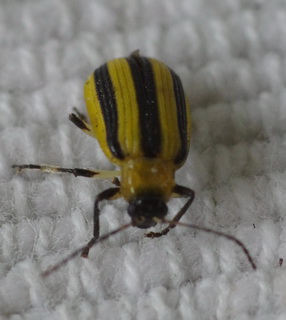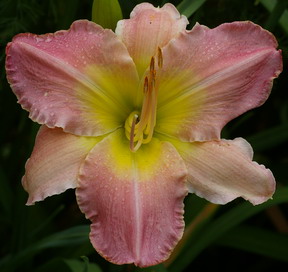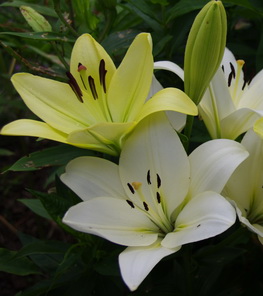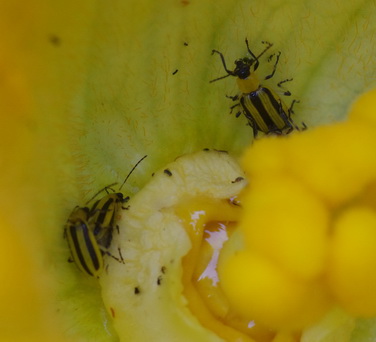| Back to Back Issues Page |
 |
|
Dallying In The Dirt, Issue #114 --- Striped cucumber beetles have invaded the garden. July 04, 2012 |

Adjusting to the constant presence of the Red Lily Beetle in my garden has been a difficult exercise but I have managed to develop a control method that gives me reasonable quality Lilies without making the beetle’s control a full time activity. While enjoying the sun and camaraderie of our local Canada Day picnic on Sunday, I was approached by an old friend with a gardening question, a not uncommon activity. She inquired if I knew anything about the Striped Cucumber Beetle, Acalymma vittata because they had invaded her garden in great numbers this year for the first time. I gave her what little information that I had and suggested a home made spray that many people had told me worked on the Red Lily Beetle. I quietly breathed a sigh of relief that I had no actual experience with this pest. Yesterday I was looking at my Zucchini, that appeared to be quite slug eaten, and discovered to my horror a cluster of 1cm beetles with three black stripes down their yellow backs. I had the Striped Cucumber Beetle. I feel I should apologize to the local slug population because I had been cursing them for wiping out my various Cucurbit crops when it apparently was this new invader.  There are better things happening in my garden. After a few years of training and pruning and coping with Clematis wilt, my Clematis Jackmanii has run all through my crab Apple tree and is now in full bloom. Huge purple blooms adorn the branches of this tree giving it an amazing summer bloom period. This tree which I prune heavily each year is essentially a giant Bonsai that forms the centre piece over my three interconnected ponds and to have it dripping with large purple blooms in early July just makes all that gardening effort worthwhile.
There are better things happening in my garden. After a few years of training and pruning and coping with Clematis wilt, my Clematis Jackmanii has run all through my crab Apple tree and is now in full bloom. Huge purple blooms adorn the branches of this tree giving it an amazing summer bloom period. This tree which I prune heavily each year is essentially a giant Bonsai that forms the centre piece over my three interconnected ponds and to have it dripping with large purple blooms in early July just makes all that gardening effort worthwhile. The Daylilies are filling the garden with their carefree blooms and the range of colours and patterns is expanding every year. Go online and search Daylily breeders to see some of the exciting colour patterns now available. Purple with yellow edges and centres and those edges are frilly as well. I need to dig up and compost some of my older varieties that are too similar to each other, to make room for these new and improved versions. I love plant breeders, always wanted to be one actually, but they cost me a lot of effort and money. Why can’t I be content with the old standards? Why do the new and different varieties attack my wallet with such enthusiasm?
The Daylilies are filling the garden with their carefree blooms and the range of colours and patterns is expanding every year. Go online and search Daylily breeders to see some of the exciting colour patterns now available. Purple with yellow edges and centres and those edges are frilly as well. I need to dig up and compost some of my older varieties that are too similar to each other, to make room for these new and improved versions. I love plant breeders, always wanted to be one actually, but they cost me a lot of effort and money. Why can’t I be content with the old standards? Why do the new and different varieties attack my wallet with such enthusiasm?  The same process is happening with the true Lilies. I do confess that I like them more than the Daylilies. Am I am just attracted to plants that are more difficult to grow. Truly, Lilies are not that much more difficult if the red lily beetle would just leave town. Growing Lilies is a matter of buying a bulb, or 6, preferably in the autumn, and sticking it into the ground. It will produce a flower stalk next spring and then multiply and produce more stalks in the coming years. The new hybrids such as the Orienpets, (who dreamed up that name,) a cross between the Oriental Lilies and the Trumpet Lilies, have even more vigour. They will easily grow at least a metre tall and will produce several thick stalks by their third year in your garden. Now if they were just resistant to the red lily beetle. There is one by the front walk that opens a rich buttery yellow and by the third day is almost white.
The same process is happening with the true Lilies. I do confess that I like them more than the Daylilies. Am I am just attracted to plants that are more difficult to grow. Truly, Lilies are not that much more difficult if the red lily beetle would just leave town. Growing Lilies is a matter of buying a bulb, or 6, preferably in the autumn, and sticking it into the ground. It will produce a flower stalk next spring and then multiply and produce more stalks in the coming years. The new hybrids such as the Orienpets, (who dreamed up that name,) a cross between the Oriental Lilies and the Trumpet Lilies, have even more vigour. They will easily grow at least a metre tall and will produce several thick stalks by their third year in your garden. Now if they were just resistant to the red lily beetle. There is one by the front walk that opens a rich buttery yellow and by the third day is almost white. The luncheon guests that arrived today, marvelled at how well the Pansies on the front step looked, despite the heat. The Impatiens and Geraniums that are going to replace them are still in the cold frame. They are big enough now to demand almost daily watering and so they will be moving out front this week sometime. The Pansies will complete their life cycle by moving to the compost heap. I get two quite different looks for the front yard this way with very little effort. I just need an hour out of the hot sun to finish the job.
The luncheon guests that arrived today, marvelled at how well the Pansies on the front step looked, despite the heat. The Impatiens and Geraniums that are going to replace them are still in the cold frame. They are big enough now to demand almost daily watering and so they will be moving out front this week sometime. The Pansies will complete their life cycle by moving to the compost heap. I get two quite different looks for the front yard this way with very little effort. I just need an hour out of the hot sun to finish the job.  Beside the house, where the soaker hose is presently running, my Raspberries, are currently soaking up all of that water and producing their rich sweet flavour. There is nothing better on a July morning. I work for a couple of very early hours, before the sun becomes unbearable and then pour a bowl of cereal, walk out and pick a pile of fresh Raspberries on top of it and retire to the very shady cool deck to enjoy the fruits of my gardening labours.
Beside the house, where the soaker hose is presently running, my Raspberries, are currently soaking up all of that water and producing their rich sweet flavour. There is nothing better on a July morning. I work for a couple of very early hours, before the sun becomes unbearable and then pour a bowl of cereal, walk out and pick a pile of fresh Raspberries on top of it and retire to the very shady cool deck to enjoy the fruits of my gardening labours.Time to answer a few questions. If you have a gardening question just ‘reply’ to this newsletter and send me your query. I try to answer most of the questions and the ones that I answer here are those that I think will have the widest interest. You can also find the latest garden updates on the front page of gardening-enjoyed.com . Marcia Asks? . I love peonies and have about 16. I would love to pick and bring them into the house, BUT I hate ants running over the blossoms and the table. Any suggestions to having peonies bug free in the house. |
| Back to Back Issues Page |
 If the actual eating of my little transplants wasn’t bad enough I have discovered that this nasty little creature also carries a bacterial wilt that it transfers to what is left of the plants, after it has had it lunch. There is no cure for this wilt, so controlling the beetle is doubly important. They are a strange beast in that they congregate inside the large yellow blossoms of the Cucurbits. They wander out during the day to eat leaves but seem to tuck in for a good night’s sleep inside the closed blossoms. Apparently they like the nectar etc. This does leave us the ability to pry open those blossoms early in the morning and zap them with a spray while they are still sleepy and slow moving. They are very fast moving and hard to hit when they are eating leaves mid day.
If the actual eating of my little transplants wasn’t bad enough I have discovered that this nasty little creature also carries a bacterial wilt that it transfers to what is left of the plants, after it has had it lunch. There is no cure for this wilt, so controlling the beetle is doubly important. They are a strange beast in that they congregate inside the large yellow blossoms of the Cucurbits. They wander out during the day to eat leaves but seem to tuck in for a good night’s sleep inside the closed blossoms. Apparently they like the nectar etc. This does leave us the ability to pry open those blossoms early in the morning and zap them with a spray while they are still sleepy and slow moving. They are very fast moving and hard to hit when they are eating leaves mid day.